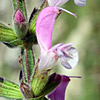Salvia hierosolymitana is one of Israel’s most beautiful flowers. It is an herbaceous perennial, endemic to the eastern Mediterranean. In Israel it blooms during March-June. The flower color of the Judea and Samaria hills ecotype is crimson/deep-red whereas the flower of the upper Galilee ecotype is pinkish. The flower is pollinated mostly by solitary large bees of the genus Anthophora, whose proboscis is long enough to reach the nectar which is produced and accumulated at the base of the flower.
The flowers of S. hierosolymitana are bilabiate with a long tapering base at the bottom of which there is a nectary that secrets nectar which accumulates at the basal part of the flower tube. The flowers have two separated sexual stages with the male phase, when the anthers release the pollen, preceding the female phase, when the stigma is receptive. During the male phase the stigma faces upwards and its lobes are clustered together. During the female phase the stigma bends down and its lobes bifurcate. Separation of the two sexual phases within the flower helps to reduce self-pollination and promote cross-pollination.
As in some other members of the Lamiaceae family S. hierosolymitana has a lever mechanism which ensures effective pollen transfer to/from the visiting Bee. In this mechanism two out of the original four stamens were modified into a paddle like structure, which is attached to the base of the filaments of the two remaining anthers and acts as the lever arms. During the flower’s male phase, once the visiting Bee is pushing the paddle with its forehead (while trying to reach the nectar), the lever arms pulls down the two pollen sacs out of the petals to touch and spread their pollen on top of the Bee’s back. During the flower’s female phase the stigma is bent down, therefore increasing the likelihood of touching the back of the visiting Bee which carries pollen from other flowers.
As in most members of the Lamiaceae family, Salvia flowers have a superior ovary of two fused carpels that form four distinct locules each with one basal ovule. The fruits consist of four one-seeded indehiscent achene-like nutlets.
The flowers are arranged in whorls, which are situated at intervals of 2–4 cm along vertical inflorescences which can be 80-100 cm tall. There are six flower buds in a whorl, 7–10 whorls per inflorescence and there are 1–5 inflorescence stems per plant. Blooming progresses from the inflorescence base upwards, so that 2–4 whorls bloom simultaneously. Buds within a whorl open gradually. The inflorescence stalk is square and covered with simple and glandular trichomes. Glandular trichomes also cover the fused sepals.
Salvia hierosolymitana is a hemicryprophyte which regrows every winter from the soil level. As in most members of the Lamiaceae family, the leaves are opposite and two adjacent leaf pairs are perpendicular to one another. This renders the stem a square cross-section. The flower bearing branches, arranged in pairs along the 80 cm tall stem, curve in opposite directions.
The Israeli botanists Dr. Ephraim and Hanah Hareuveni pointed out that the architecture of the vertical inflorescence of this species of Salvia resembles the shape of the Menorah. Therefore, they suggested that it had inspired the design of the Menorah. Moreover, based on etymology perspectives they suggested that the Hebrew word “Marva” (Salvia) was originated from the Hebrew word “Moriah” (the Temple Mount name), reflecting the connection between this plant and the Menorah, which was situated inside the Holy Temple in Jerusalem.
Written by Yehoram Leshem




